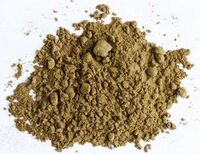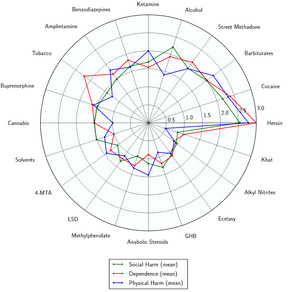Morphine

Fatal overdose may occur when opiates are combined with other depressants such as benzodiazepines, barbiturates, gabapentinoids, thienodiazepines, alcohol or other GABAergic substances.[1]
It is strongly discouraged to combine these substances, particularly in common to heavy doses.
| Morphine | |||||||||||||||||||||||||||||||||||||||||||||||||||||||||||||||||
|---|---|---|---|---|---|---|---|---|---|---|---|---|---|---|---|---|---|---|---|---|---|---|---|---|---|---|---|---|---|---|---|---|---|---|---|---|---|---|---|---|---|---|---|---|---|---|---|---|---|---|---|---|---|---|---|---|---|---|---|---|---|---|---|---|---|
 |
|||||||||||||||||||||||||||||||||||||||||||||||||||||||||||||||||
| Chemical Nomenclature | |||||||||||||||||||||||||||||||||||||||||||||||||||||||||||||||||
| Common names | Morphine, MS-Contin, Oramorph, Zomorph, Sevredol, Duramorph | ||||||||||||||||||||||||||||||||||||||||||||||||||||||||||||||||
| Substitutive name | Morphine | ||||||||||||||||||||||||||||||||||||||||||||||||||||||||||||||||
| Systematic name | (5α,6α)-7,8-didehydro-4,5-epoxy-17-methylmorphinan-3,6-diol | ||||||||||||||||||||||||||||||||||||||||||||||||||||||||||||||||
| Class Membership | |||||||||||||||||||||||||||||||||||||||||||||||||||||||||||||||||
| Psychoactive class | Opioid | ||||||||||||||||||||||||||||||||||||||||||||||||||||||||||||||||
| Chemical class | Morphinan | ||||||||||||||||||||||||||||||||||||||||||||||||||||||||||||||||
| Routes of Administration | |||||||||||||||||||||||||||||||||||||||||||||||||||||||||||||||||
|
|||||||||||||||||||||||||||||||||||||||||||||||||||||||||||||||||
| Interactions | |||||||||||||||||||||||||||||||||||||||||||||||||||||||||||||||||
| Stimulants | |||||||||||||||||||||||||||||||||||||||||||||||||||||||||||||||||
| MAOIs | |||||||||||||||||||||||||||||||||||||||||||||||||||||||||||||||||
| Nitrous | |||||||||||||||||||||||||||||||||||||||||||||||||||||||||||||||||
| PCP | |||||||||||||||||||||||||||||||||||||||||||||||||||||||||||||||||
| Alcohol | |||||||||||||||||||||||||||||||||||||||||||||||||||||||||||||||||
| Benzodiazepines | |||||||||||||||||||||||||||||||||||||||||||||||||||||||||||||||||
| DXM | |||||||||||||||||||||||||||||||||||||||||||||||||||||||||||||||||
| GHB | |||||||||||||||||||||||||||||||||||||||||||||||||||||||||||||||||
| GBL | |||||||||||||||||||||||||||||||||||||||||||||||||||||||||||||||||
| Ketamine | |||||||||||||||||||||||||||||||||||||||||||||||||||||||||||||||||
| MXE | |||||||||||||||||||||||||||||||||||||||||||||||||||||||||||||||||
| Tramadol | |||||||||||||||||||||||||||||||||||||||||||||||||||||||||||||||||
| Grapefruit | |||||||||||||||||||||||||||||||||||||||||||||||||||||||||||||||||

Morphine is a natural opioid analgesic found in alkaloids from the latex of the poppy plant (Papaver somniferum). As with other opioids, it is used as both medication and as a recreational drug for the relaxation and intense euphoria it induces. Potentially serious side effects include a decreased respiratory effort and low blood pressure. If the dose is reduced after long term use withdrawal may occur. Common side effects include drowsiness, vomiting, and constipation. Frequent and regular administration is associated with tolerance, addiction and physical dependence.
It can be administered orally, intramuscularly, subcutaneously, intravenously, into the space around the spinal cord, or rectally.[5] Maximum effect is around 20 min when given intravenously and 60 min when given by mouth while duration of effect is between three and seven hours.[5][6] Long acting formulations also exist.[5]
Morphine was first isolated between 1803 and 1805 by Friedrich Sertürner.[7] This is generally believed to be the first isolation of an active ingredient from a plant.[8] Merck began marketing it commercially in 1827.[7] Morphine was more widely used after the invention of the hypodermic syringe in 1853–1855.[7][9] Sertürner originally named the substance morphium after the Greek god of dreams, Morpheus, for its tendency to cause sleep.[9][10]
The primary source of morphine is isolation from poppy straw of the opium poppy.[11] In 2013 an estimated 523,000 kilograms of morphine were produced.[12] About 45,000 kilograms were used directly for pain, an increase over the last twenty years of four times.[12] Most use for this purpose was in the developed world.[12] About 70% of morphine is used to make other opioids such as hydromorphone, oxycodone, heroin, and methadone.[12][13][14] It is a Schedule II drug in the United States,[13] Class A in the United Kingdom,[15] and Schedule I in Canada.[16] It is on the WHO Model List of Essential Medicines, a list of the most important medications needed in a basic health system.[17]
Chemistry
 |
This chemistry section is incomplete. You can help by adding to it. |
Pharmacology
Morphine molecules exert their effects by binding to and activating the μ-opioid receptor as agonist. This occurs due to the way in which opioids structurally mimic endogenous endorphins. Endorphins are responsible for analgesia (reducing pain), causing sleepiness, and feelings of pleasure. They can be released in response to pain, strenuous exercise, orgasm, or excitement. This mimicking of natural endorphins results in the drug's euphoric, analgesic (pain relief), and anxiolytic (anti-anxiety) effects.
These appear to stem from the way in which opioids appear to mimic endogenous endorphins. Endorphins are responsible for analgesia (reducing pain), causing sleepiness, and feelings of pleasure. They can be released in response to pain, strenuous exercise, orgasm, or excitement. This mimicking of natural endorphins results in the drug's effects.
Subjective effects
The effects listed below are based upon the subjective effects index and personal experiences of PsychonautWiki contributors. The listed effects will rarely (if ever) occur all at once, but heavier dosages will increase the chances and are more likely to induce a full range of effects.
Physical effects
- Euphoria - The physical euphoria experienced on this substance is extremely intense when compared to other opioids such as codeine or tramadol. The sensation itself can be described as feelings of intense physical comfort, warmth, love and blissful euphoria.
- Pain relief - This component is subjectively different from other anaesthetics as it does not necessarily remove the pain entirely whilst still remaining equal in terms of its effectiveness. Instead of directly suppressing pain, these substances dull the perceived sensation and cover it up with feelings of physical and emotional pleasure.
- Respiratory depression
- Itchiness
- Constipation
- Cough suppression
- Difficulty urinating
- Nausea
- Sedation
- Pupil constriction
Cognitive effects
The cognitive effects of morphine can be broken down into several components which progressively intensify proportional to dosage. The most prominent of these cognitive effects generally include:
- Euphoria - The cognitive euphoria experienced on this substance is extremely intense when compared to other opioids such as codeine or tramadol. The sensation itself can be described as powerful and overwhelming feelings of emotional bliss, contentment, love and happiness.
- Anxiety suppression
- Compulsive redosing
Visual effects
- Internal hallucinations - One may experience a state of semi-consciousness and hypnagogia during heavy dosage nodding which results in dream-like states and up to level 3 imagery. This is often accompanied by ill-defined geometry.
Toxicity and harm potential

Like most opioids, unadulterated morphine does not cause many long-term complications other than dependence and constipation.[7] Outside of the extremely powerful addiction and physical dependence, the harmful or toxic aspects of morphine usage are exclusively associated with not taking appropriate precautions in regards to its administration, overdosing and using impure products.
Heavy dosages of morphine can result in respiratory depression leading onto fatal or dangerous levels of anoxia (oxygen deprivation). This occurs because the breathing reflex is suppressed by agonism of µ-opioid receptors proportional to the dosage consumed.
Morphine can also cause nausea and vomiting; a significant number of deaths attributed to heroin overdose are caused by aspiration of vomit by an unconscious victim. This is when an unconscious or semi-conscious user who is lying on their back vomits into their mouth and unknowingly suffocates. It can be prevented by ensuring that one is lying on their side with their head tilted downwards so that the airways cannot be blocked in the event of vomiting while unconscious.
Tolerance and addiction potential
As with other opiate-based painkillers, the chronic use of morphine can be considered extremely addictive and is capable of causing both physical and psychological dependence. When physical dependence has developed, withdrawal symptoms may occur if a person suddenly stops their usage.
Tolerance to many of the effects of morphine develops with prolonged use, including therapeutic effects. This results in users having to administer increasingly large doses to achieve the same effects. The rate at which this occurs develops at different rates for different effects with tolerance to the constipation-inducing effects developing particularly slowly.
Interactions
Morphine is dangerous to use in combination with other depressants as many fatalities reported as overdoses are caused by interactions with other depressant drugs like alcohol or benzodiazepines, resulting in dangerously high levels of respiratory depression.[8]
Legal issues
 |
This legality section is a stub. As such, it may contain incomplete or wrong information. You can help by expanding it. |
See also
External links
References
- ↑ Risks of Combining Depressants - TripSit
- ↑ "Medsafe (PDF)
- ↑ "FDA (PDF)
- ↑ "South Australian Neonatal Medication Guidelines (PDF)
- ↑ "Pfizer
- ↑ Development of a rational scale to assess the harm of drugs of potential misuse | http://www.sciencedirect.com/science/article/pii/S0140673607604644
- ↑ Merck Manual of Home Health Handbook – 2nd edition, 2003, p. 2097
- ↑ Fatal heroin 'overdose': a review | http://www.ncbi.nlm.nih.gov/pubmed/8997759